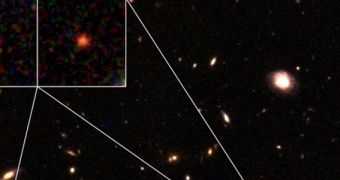An international group of astronomers recently used data collected by the NASA/ESA Hubble Space Telescope to discover massive galaxies in the early Universe. The finding raises some interesting questions, since galaxy formation rates were thought to be average just a few hundreds of millions of years following the Big Bang. Scientists now plan to figure out how these large galaxies assembled.
The new investigation observed a series of galaxies as they appeared when the entire Cosmos was just 1.6 billion years old. The Universe is now thought to be around 13.75 billion years old. So long ago, galaxies across the board were producing stars at a large pace, so most of the structures visible to modern telescopes are caught in full-on stellar-formation processes.
What makes the recently-discovered galaxies different from all the others that existed around the same time is that they were already fully-formed and massive at the time the study was conducted. Astronomers are now very curious to learn what drove these objects to grow up so fast. Details of the new study appear in the latest issue of the esteemed Astrophysical Journal Letters.
The research group included astronomers Eric Persson and Andy Monson, from the Carnegie Institution for Science (CIS). The experts say that massive, fully-formed galaxies should have not existed roughly 12 billion years ago. The work also included Leiden University lead study author Caroline Straatman and principal investigator Ivo Labbe.
The new study of deep space was conducted at near-infrared wavelengths, allowing scientists to detect areas featuring no new stellar formation, as well as red, old stars. In optical wavelengths, the two galaxies found in this research are nearly invisible and extremely hard to detect. What the team found is that they already contained around 100 billion stars each so long ago.
One possible explanation for their existence is an explosive rate of stellar formation, which may have enabled these Milky Way-like objects to evolve to their large sizes within just 1 billion years. If that is true, then new stars were formed at several hundred times the rate we see in our own galaxy today.
The objects were discovered with the FourStar camera on the Magellan Baade Telescope, which is located at the CIS Las Campanas Observatory in Chile. Confirmation was provided by the Cosmic Assembly Near-infrared Deep Extragalactic Legacy Survey and the Great Observatories Origins Deep Survey, both conducted with Hubble.
Thousands of different galaxies were covered in this investigation, which also provides a simple, 3D map of the early Universe. This investigation suggests that this critical time in the history of the Cosmos may in fact be a lot more mysterious than previously suggested.
Scientists now plan to conduct additional studies to figure out the nature of the process or event that prevented these galaxies from growing continuously. Another area of research will be to establish exactly where these galaxies came from and how their stellar formation got to such high levels.

 14 DAY TRIAL //
14 DAY TRIAL //